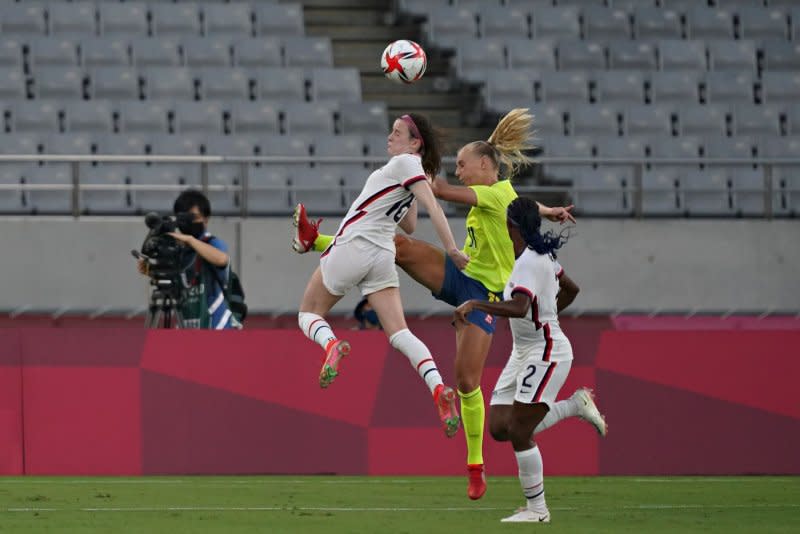Soccer ball heading may impair brain function, study says

- Oops!Something went wrong.Please try again later.
NEW YORK, Nov. 28 (UPI) -- Soccer players who hit the ball with their head may suffer a measurable decline in brain function, according to new research to be presented this week at the annual meeting of the Radiological Society of North America in Chicago.
"Repeated impacts to the head, even when it's not a recognized injury, may add up and cause problems later in life," the study's senior author, Dr. Michael L. Lipton, a professor of radiology at Columbia University's Vagelos College of Physicians and Surgeons, told UPI in a telephone interview.
"The potential for repeated sport-related head impacts sustained over many years to cause neurodegenerative disease and dementia are areas of great worldwide concern," said Lipton, who also is an affiliate professor of biomedical engineering at Columbia.
He added, however, that "more research is needed to understand the potential of these brain changes to lead to long-term harm."
While earlier research has looked at adverse effects on the brain related to soccer heading at a single point in time, this study examined brain changes over two years.

The study involved 148 amateur soccer players with an average age of 27. Of this group, 38 participants (26%) were female.
Researchers developed a specialized questionnaire for players to determine how often they hit the soccer ball with their head. Based on the responses, heading exposure was categorized as low, moderate or high over the two-year period.
Players were evaluated for verbal learning and memory and underwent diffusion tensor imaging, an MRI technique, at the time of enrollment and two years later. This technique characterizes the microstructure of the brain by tracking the microscopic movement of water molecules through the tissue, according to a news release.
The analysis revealed that high levels of heading over the two-year period were linked to changes in brain microstructure similar to findings seen in mild traumatic brain injuries. High levels of heading also were associated with a decline in verbal learning performance.
Lipton and his colleagues also were scheduled to present another study at the annual meeting on the association between repetitive head impacts from soccer heading and verbal learning performance. They used the same techniques.
For the second study, researchers analyzed heading over 12 months before the MRI technique and verbal learning performance testing in 353 amateur soccer players, ages 18 to 53, of whom 27% were female.
Unlike the research that focused on deep white matter regions, this study employed a new technique to assess the integrity of the interface between the brain's gray and white matter closer to the skull.
Researchers found that the normally sharp gray matter-white matter interface was blunted in proportion to high repetitive head impact exposure.
The results are not surprising, Dr. Charles Bernick, a neurologist at the Cleveland Clinic Lou Ruvo Center for Brain Health in Las Vegas, who was not involved with the research, told UPI in a telephone interview.
Bernick is the lead researcher of the Professional Athlete's Brain Health Study, which is looking into the long-term effects of repetitive head impacts. He said it's unclear whether the brain can repair the microstructural changes seen on MRI once the athlete stops playing.
"You need a lot more work to be done in this field," he said. "I don't think we know what the true risk of permanent brain injury is from heading the ball in soccer."
While the research is strong overall, it may not be as generalizable to female athletes because only about one-fourth of the participants were female, Dr. Shae Datta, a sports neurologist and co-director of the NYU Langone Concussion Center in New York City, told UPI in a telephone interview.
Even so, the researchers demonstrated that more soccer ball hits with the head resulted in a greater number of changes in the white matter situated in the brain's frontal lobe. This could have a negative effect on memory in the future, Datta said.
"It's interesting because this is the first study to show the change in brain structure over time," she said, noting that the findings will be helpful in talking with patients about the potential injuries they could incur while playing soccer.
There are other ways to play this sport -- by bouncing a ball off the knee or the torso as opposed to the head, which Datta described as "a sensitive area" and "the motherboard of our body."
Using a survey may not be the best way to quantify the number of hits with a soccer ball, but the research still provides valuable insight, Dr. Russell Lonser, professor and chair of the department of neurosurgery at Ohio State University's Wexner Medical Center and College of Medicine in Columbus, told UPI in a telephone interview.
"Anything that advances understanding of mild head injury is an important step forward," Lonser said, adding that "we do not know if the imaging or clinical findings are reversible without long-term data, and it will important for the authors of the study to continue to pursue that."

